Categories
- Antiques & Collectibles 13
- Architecture 36
- Art 48
- Bibles 22
- Biography & Autobiography 813
- Body, Mind & Spirit 142
- Business & Economics 28
- Children's Books 15
- Children's Fiction 12
- Computers 4
- Cooking 94
- Crafts & Hobbies 4
- Drama 346
- Education 46
- Family & Relationships 57
- Fiction 11829
- Games 19
- Gardening 17
- Health & Fitness 34
- History 1377
- House & Home 1
- Humor 147
- Juvenile Fiction 1873
- Juvenile Nonfiction 202
- Language Arts & Disciplines 88
- Law 16
- Literary Collections 686
- Literary Criticism 179
- Mathematics 13
- Medical 41
- Music 40
- Nature 179
- Non-Classifiable 1768
- Performing Arts 7
- Periodicals 1453
- Philosophy 64
- Photography 2
- Poetry 896
- Political Science 203
- Psychology 42
- Reference 154
- Religion 513
- Science 126
- Self-Help 84
- Social Science 81
- Sports & Recreation 34
- Study Aids 3
- Technology & Engineering 59
- Transportation 23
- Travel 463
- True Crime 29
Sort by:
Cynarctus fortidens new species Holotype.—Right maxilla bearing P3, P4, and M1, No. 11353 KU; bluff on west side of Turkey Creek, approximately 75 feet above stream, Raymond Farr Ranch, Center NE, NE, S. 48 Blk. C-3, E. L. and R. R. Ry. Co., Donley County, Texas [approximately 6.5 miles north and 1 mile east of Clarendon], Clarendon fauna, Early Pliocene age. Obtained by W. W. Dalquest, on June 25,...
more...
by:
Lucy Larcom
BY THE RIVER. IT did not take us younger ones long to get acquainted with our new home, and to love it. To live beside a river had been to me a child's dream of romance. Rivers, as I pictured them, came down from the mountains, and were born in the clouds. They were bordered by green meadows, and graceful trees leaned over to gaze into their bright mirrors. Our shallow tidal creek was the only...
more...
In the summer of 1946 a party from the University of Kansas Museum of Natural History visited exposures of the Laverne formation in Beaver County, Oklahoma, at the invitation of Dr. Stuart Schoff of the United States Geological Survey. When examining the marl beds an Emydid turtle was discovered which appears to be an unnamed species of the genus Chrysemys. A description of the new species follows....
more...
by:
Joan Echols
Discussion.—Because of the great differences in endocranial structure between the Devonian and Pennsylvanian coelacanths, they are here placed in new subfamilies. The two proposed subfamilies of the family Diplocercidae are the Diplocercinae and the Rhabdodermatinae. The Diplocercinae include those coelacanths having two large unpaired bones in the endocranium (at present this includes Diplocercides...
more...
by:
John Mason Peck
CHAPTER I. Its extent,—Subdivisions,—Population,—Physical features,—Animal, Vegetable and Mineral productions,—History,—Prospective increase of Population. The Valley of the Mississippi, in its proper geographical extent, embraces all that portion of the United States, lying between the Alleghany and Rocky Mountains, the waters of which are discharged into the gulf of Mexico, through the...
more...
A NEW HOCHELAGAN BURYING-GROUND BY W.D. LIGHTHALL The above title is provisional as respects the term "Hochelagan." All those who are interested in the Indians of old Hochelaga, or in the Mohawks with whom they seem to have had a close and not yet fully ascertained race relationship, will be pleased to learn of the discovery of a prehistoric burying-ground which is probably one of their race,...
more...
by:
Edward H. Taylor
A small collection of Mexican reptiles and amphibians recently acquired by the University of Kansas Natural History Museum contains five specimens of a species of the genus Hyla (sensu lato) which is here described as new. Hyla proboscidea sp. nov. Type.—University of Kansas Museum of Natural History, No. 23626, collected 2 km. west of Jico, Veracruz, Mexico, at an elevation of 4,200 ft., Oct. 28,...
more...
Mr. Rarey is a farmer from Ohio, in the United States. Five years ago he wrote the little book which forms the text of the following complete account of his system, with pictorial illustrations, which are essential for explaining the means he now employs for subduing the most refractory animals. Without these explanations, it would be extremely difficult for any one who had not enjoyed the advantage of...
more...
Long-eared bats obtained by field parties from the University of Kansas in the Mexican states of Coahuila, Nuevo León, and Tamaulipas, are found to belong to the species, Myotis evotis, but are not referable to any named subspecies. They are named and described as follows: Myotis evotis auriculus new subspecies Type.—Female, adult, skin and skull; No. 55110, Univ. Kansas Mus. Nat. Hist.; 10 mi. W...
more...
When Gerrit S. Miller, Jr., published his "Revision of the North American Bats of the Family Vespertilionidae" (N. Amer. Fauna, 13:1-140, 3 pls., 39 figs. in text, October 16, 1897), the red bat, Lasiurus borealis, was known from the southern half of Mexico but he did not know that the hoary bat, Lasiurus cinereus, also occurred there. Therefore, the name A[talapha]. mexicana Saussure (Revue et...
more...











